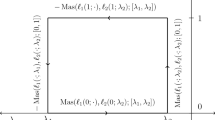Abstract
This paper deals with Hamiltonian perturbation theory for systems which, like Euler-Poinsot (the rigid body with a fixed point and no torques), are degenerate and do not possess a global system of action-angle coordinates. It turns out that the usual methods of perturbation theory, which are essentially ‘local’ being based on the construction of normal forms within the domain of a local coordinate system, are not immediately usable to study perturbations of these systems, since degeneracy makes impossible to control that the system does not fall into a singularity of the coordinates. To overcome this difficulty, we develop a ‘global’ formulation of Hamiltonian perturbation theory, in which the normal forms are globally defined on the phase space manifold. The key for this study lies in the geometry of the fibration by the invariant tori of an integrable degenerate Hamiltonian system, which is described by some generalizations of the Liouville-Arnol'd theorem and is reviewed in the paper. As an application, we provide a ‘global’ formulation of Nekhoroshev's theorem on the stability for exponentially long times.
Similar content being viewed by others
References
N.N. Nekhoroshev, 1972: ‘Action-angle variables and their generalizations’.Trudy Moskov. Mat. Obsc. 26, 181–198 [Trans. Moskow Math. Soc. 26, 180–198 (1972)].
J.J. Duistermaat, 1980: ‘On global action-angle coordinates’.Commun. Pure Appl. Math. 33, 687–706.
P. Dazord and T. Delzant, 1987: ‘Le probleme general des variables actions-angles’.J. Diff. Geom. 26, 223–251.
A.T. Fomenko, 1988:Integrability and nonintegrability in geometry and mechanics (Kluwer, Dordrecht).
M.V. Karasaev and V.P. Maslov, 1993:Nonlinear Possion Brackets. Geometry and Quantization. Translations of the AMS, Volume 119 (AMS, Providence, Rhode Island).
R. Cushman, 1983: ‘Geometry of the energy momentum mapping of the spherical pendulum’.Centrum voor Wiskunde en Informatica Newsletter 1, 4–18.
R. Cushman and H. Knörrer, 1985:The energy-momentum mapping of the Lagrange top, inDifferential geometric methods in mathematical physics, H.D. Doebner and J.D. Henning editors,Lect. Notes Math. No. 1139 (Springer Verlag, Berlin).
J. Moser, 1970: ‘Regularization of Kepler's problem and the averaging method on a manifold’.Commun. Pure Appl. Math. 23, 609–636.
S.L. Coffey, A. Deprit and B.R. Miller, 1986: ‘The critical inclination in artificial satellite theory’.Celestial Mechanics 39, 365–406.
F. Fassò, 1994: ‘On the Geometry of the Euler-Poinsot system’. Preprint.
V.I. Arnold, 1963: ‘Small denominators and problems of stability of motion in classical and celestial mechanics’,Usp. Mat. Nauk 18:6, 91–192 [Russ. Math. Surv. 18:6, 85–191 (1963)].
V.I. Arnold, V.V. Kozlov and A.I. Neishtadt, 1988:Mathematical aspects of classical and celestial mechanics, inDynamical system III, Volume 3 ofEncyclopedia of Mathematical Sciences, V.I. Arnold editor (Springer-Verlag, Berlin).
N.N. Nekhoroshev, 1977: ‘An exponential estimate of the time of stability of nearly integrable Hamiltonian systems’.Usp. Mat. Nauk 32:6, 5–66 [Russ. Math. Surv. 32:6, 1–65 (1977)].
G. Benettin and G. Gallavotti, 1986: ‘Stability of motions near resonances in quasi-integrable Hamiltonian systems’.J. Stat. Phys. 44, 293–338.
J. Pöschel, 1993: ‘Nekhoroshev estimates for quasi-convex Hamiltonian Systems’,Math. Z. 213, 187–216.
F. Fassò, 1991:Fast rotations of the rigid body and Hamiltonian perturbation theory. Ph.D. thesis, SISSA, Trieste.
G. Benettin and F. Fassò, 1994: ‘Fast rotations of the symmetric rigid body: A study by Hamiltonian perturbation theory’. Preprint.
R. Cushman, 1984:Normal Form for Hamiltonian Vectorfields with Periodic Flow, inDifferential Geometric Methods in Mathematical Physics, S. Sternberg editor, 125–144 (Reidel, Dordrecht).
J. Henrard, 1974: ‘Virtual singularities in the artificial satellite theory’.Celestial Mechanics 10, 437.
F. Fassò, 1994:Perturbation theory for systems without global action-angle coordinates, inHamiltonian Mechanics: Integrability and Chaotic Behaviour, J. Seimenis editor, 113–120 (Plenum, New York).
L.M. Bates, 1991: ‘Monodromy in the champagne bottle’.J. Appl. Math. Phys. (ZAMP)42, 837–847.
L.M. Bates, 1988: ‘Examples for obstructions to action-angle coordinates’.Proc. Roy. Soc. Edinburgh 110A, 27–30.
J.A. Serret, 1866: Mémoire sur l'emploi de la méthode de la variation des arbitraires dans la théorie des mouvements des rotation. Mémoires de l'Académie des Sciences de Paris,35, 585–616.
H. Andoyer, 1923:Cours de Mécanique Céleste (Gauthier-Villars, Paris).
A. Deprit, 1967: ‘Free rotation of a rigid body studied in phase plane’.Am. J. Phys. 55, 424–428.
F. Boigey, 1971: ‘Une transformation canonique de Mathieu dans l'espace des phases du mouvement d'un solid mobile autour d'un point fixe’.C. R. Acad. Sc., Ser A 272, 1115–1118.
F. Boigey, 1972: ‘Une théorie des perturbations en variable angles-actions. Application au mouvement d'un solide autour d'un point fixe. Précession-nutation’.J. de Méc. 11, 521–543.
V.I. Arnold, 1980:Chapitres supplémentaires de la théorie des équations différentielles ordinaires (MIR, Moscow).
Author information
Authors and Affiliations
Rights and permissions
About this article
Cite this article
Fassò, F. Hamiltonian perturbation theory on a manifold. Celestial Mech Dyn Astr 62, 43–69 (1995). https://doi.org/10.1007/BF00692068
Received:
Accepted:
Issue Date:
DOI: https://doi.org/10.1007/BF00692068




